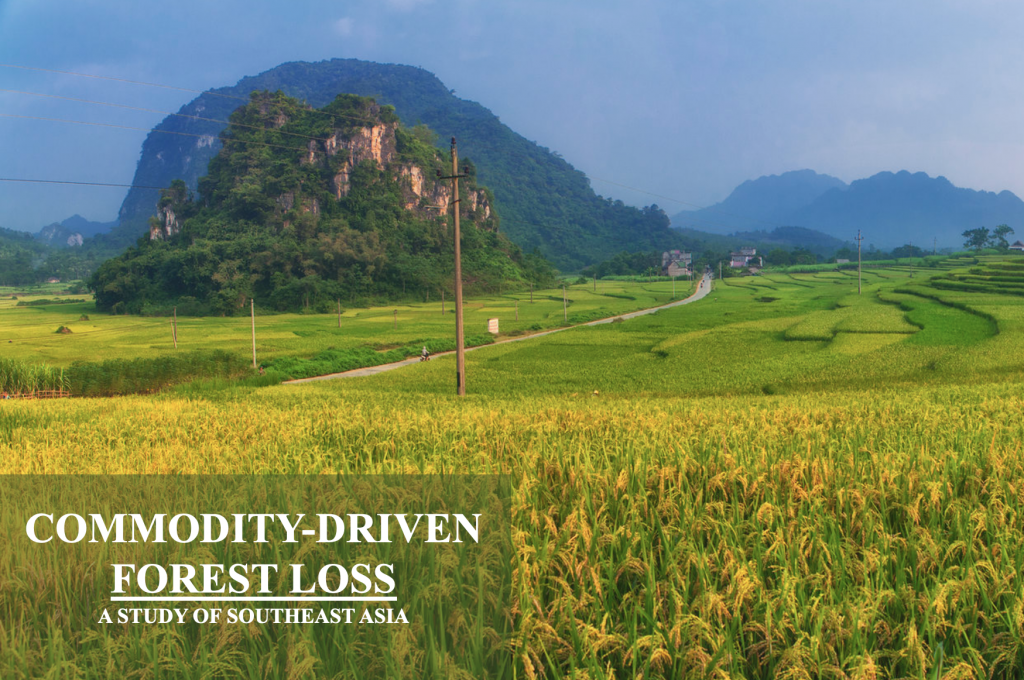Pathways to Re-boost Sustainable Agriculture, Forestry, and Land use in Southeast Asia

The United States Agency for International Development’s Regional Development Mission for Asia (USAID/RDMA) recently released “Commodity-Driven Forest Loss: A Study of Southeast Asia,” a report exploring trade-offs between agricultural production and forest conservation and offering a range of data-driven recommendations to guide land use decision-makers, the private sector, and development partners in promoting sustainable economic and low emission development strategies.
The report represents the culmination of a nearly two-year study conducted by the U.S. Department of Agriculture’s Forest Service (USFS), Spatial Informatics Group (SIG), World Agroforestry Centre (ICRAF), and SERVIR-Mekong. The study focused on seven countries: Cambodia, Indonesia, Lao PDR, Myanmar, Philippines, Thailand, and Vietnam. Its goals were to determine the primary crops that have replaced natural forests from 2000 to 2015 and to calculate the carbon losses or gains associated with these conversions.
In its key findings, the report concluded that a total of 15.8 million hectares (ha) of forestlands in Southeast Asia were lost between 2000 and 2015, and that about 9.4 million ha of that land now support crops. About 3 million ha of these forestlands were converted to herbaceous crops, such as cassava and cereal grains, representing 32 percent of the lost forestlands now under cultivation. Another 26 percent of the lost forest lands were converted to oil palm production. The aboveground biomass of the crops replacing forests stored 269 million tonnes of carbon, compared to 1.7 billion tonnes if these lands had remained forested. This is a loss of 85 percent, and equivalent to the greenhouse gas (GHG) emissions from approximately 280 million passenger vehicles driven for one year.
Perhaps the most surprising finding is oil palm and rubber were not the primary causes of deforestation in the region. While these crops were the prime driver of deforestation in Indonesia, at a regional level, forests were replaced primarily by traditional herbaceous row crops (such as cereal grains and cassava), orchards, or some combination of these.
On formerly forested lands, nearly 140 million ha were covered in monoculture crops across the region, while just over 129 million ha were covered in some form of agri-silviculture. Natural forest contained far more carbon in aboveground biomass than an equivalent area of any type of crop grown in a monoculture, as well as more than any crop grown in an agroforestry system (agroforestry is the integration of trees, crops, and/or livestock on the same plot of land). However, some agroforestry systems contained nearly as much carbon as early growth or degraded natural forest—suggesting a large potential for carbon storage through agroforestry.
While the report provides nine region-wide recommendations in addition to country-specific recommendations, one recommendation is worth emphasizing: Agroforestry practices should be implemented more broadly in existing monoculture plantations. Agroforestry can quickly improve landscape carbon storage while also likely improving production capacity and some ecosystem services.
All the recommendations are now implemented in the region, although at a limited scale and scope. National and local governments must scale up locally appropriate practices. Only through innovative, pro-people, pro-environmental policy change will the region begin to follow a path of climate-friendly development that preserves life on land while helping people realize a life without hunger or poverty.
The full report and a summary for policymakers can be accessed here: https://servir.adpc.net/publications/commodity-driven-forest-loss-a-study-of-southeast-asia
This report leveraged data collection in Collect Earth Online, an OpenForis tool that enables multi-user data collection using high-resolution imagery, and analysis using Google Earth Engine, a cloud-based geoprocessing platform.



